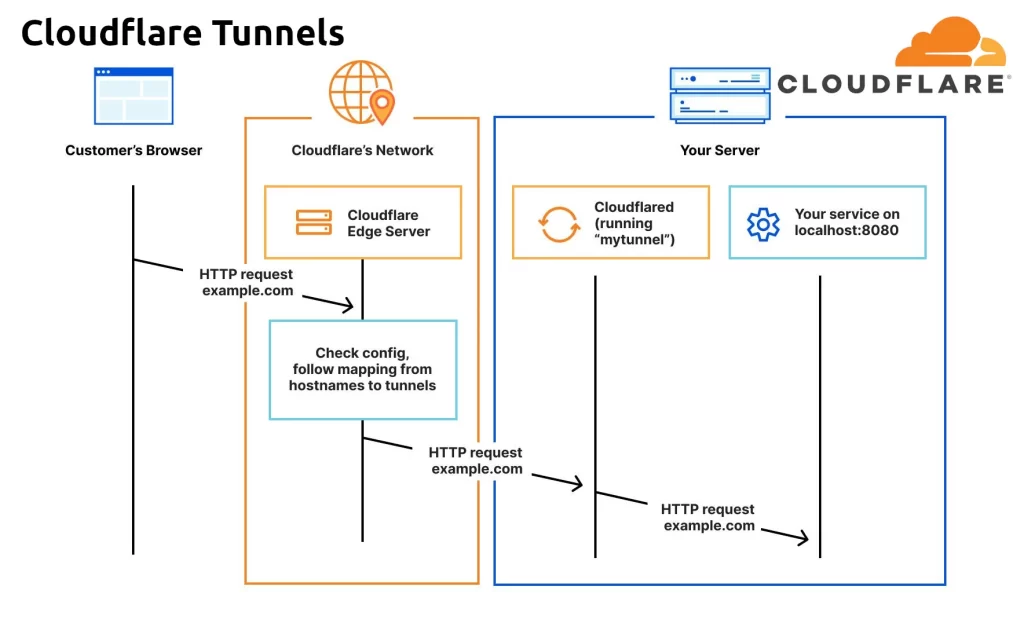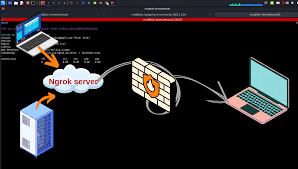What is Ngrok?
Ngrok is a tool that facilitates secure introspectable tunnels to localhost. This software is commonly utilized by developers to expose a local development server to the internet. The primary purpose of Ngrok is to create a public URL that directs traffic to a locally running service. This feature is especially useful for testing webhooks, APIs, and for demo purposes where an external service needs to interact with a local application.
Ngrok operates by creating a secure tunnel between a local machine and a publicly accessible endpoint. This tunnel allows external devices to communicate with a local server without the need for complex network configurations, such as setting up port forwarding on a router. The secure tunnels provided by Ngrok ensure that the data transmitted between the endpoints is encrypted and safe from eavesdropping.
How to Use Ngrok
To use Ngrok, the following steps can be followed:
- Download and Install Ngrok: The official Ngrok website provides executable files for various operating systems, including Windows, macOS, and Linux. The appropriate version for the operating system in use should be downloaded and installed.
- Sign Up and Authenticate: While Ngrok can be used without an account, signing up for an account provides additional features such as custom subdomains, reserved domains, and more extensive logging. Once an account is created, an authentication token will be provided, which can be used to authenticate the local Ngrok client.
- Start a Tunnel: The command-line interface (CLI) of Ngrok can be used to start a tunnel. The basic command
ngrok http <port>will create an HTTP tunnel to the specified local port. For instance,ngrok http 8080will expose the local server running on port 8080 to the internet. - Access the Public URL: Once the tunnel is active, Ngrok will provide a public URL, typically in the form of
https://<subdomain>.ngrok.io. This URL can be shared with others or used for testing external integrations. Traffic to this URL will be forwarded to the local server. - Inspect Traffic: Ngrok provides a web interface accessible at
http://localhost:4040. This interface allows the inspection of HTTP traffic passing through the tunnel. Detailed request and response information can be viewed, making it easier to debug and monitor the interactions.
Pros of Ngrok
- Ease of Use: Ngrok is user-friendly and does not require complex setup or configurations. The CLI is straightforward, and tunnels can be started with minimal commands.
- Security: Tunnels created by Ngrok are encrypted, ensuring that data transmitted between the local machine and the public endpoint is secure. This is especially important when dealing with sensitive data or secure applications.
- Instant Public URLs: Ngrok provides instant public URLs, which can be used to expose local services to the internet quickly. This feature is beneficial for sharing demos, testing webhooks, and remote development.
- Traffic Inspection: The ability to inspect traffic through the web interface is a significant advantage. It allows developers to debug issues by viewing detailed request and response information.
- Cross-Platform Compatibility: Ngrok supports multiple operating systems, including Windows, macOS, and Linux, making it accessible to a wide range of developers.
Cons of Ngrok
- Limited Free Tier: The free tier of Ngrok comes with limitations, such as restricted session durations, limited tunnels, and fewer customizations. Advanced features are available only with paid plans.
- Latency: While Ngrok generally performs well, there can be some latency introduced due to the tunnel. For high-performance applications, this added latency might be noticeable.
- Dependency: Using Ngrok creates a dependency on an external service. If Ngrok experiences downtime or issues, it can disrupt the workflow and access to the local server.
- Security Considerations: Although Ngrok provides encryption, exposing a local server to the internet always carries security risks. Proper security measures should be implemented on the local server to mitigate potential threats.
- Learning Curve: For those unfamiliar with command-line interfaces or tunneling concepts, there might be a slight learning curve. Understanding how to use Ngrok effectively requires some familiarity with these topics.
Top 10 Ngrok Alternatives

In the realm of web development and remote access, Ngrok has been utilized extensively for tunneling local servers to the public internet. However, a plethora of alternatives exist, each with unique features that can cater to various needs. This log will delve into the top 10 Ngrok alternatives, highlighting their features, benefits, and potential use cases.
1. Localtunnel
Localtunnel is an open-source project that provides similar functionality to Ngrok. It is used to expose local servers to the internet securely. The setup is straightforward, and it is integrated with npm, making it convenient for developers already using Node.js.
Features:
- Quick setup through npm.
- Custom subdomains can be used.
- Simple command-line interface.
- Free to use.
Localtunnel is ideal for developers who need a straightforward solution without extensive features.
2. Serveo
Serveo offers a seamless way to expose local servers to the internet without any installation required. It is accessed via SSH, making it a secure and efficient alternative to Ngrok.
Features:
- No installation needed.
- Secure connection via SSH.
- Custom subdomains available.
- Supports HTTP and HTTPS.
Serveo is recommended for those who prefer not to install additional software and want a secure connection through SSH.
3. Pagekite
Pagekite is another robust alternative that has been around for a while. It provides a user-friendly interface and supports a wide range of protocols, including HTTP, HTTPS, SSH, and TCP.
Features:
- Supports multiple protocols.
- Custom subdomains and wildcards.
- Easy-to-use setup.
- Free tier available with limitations.
Pagekite is suitable for users who require flexibility in the protocols they wish to tunnel.
4. LocalXpose
LocalXpose focuses on security and simplicity. It provides an intuitive interface and supports multiple regions, making it a reliable choice for developers and testers.
Features:
- Secure tunnels with end-to-end encryption.
- Multiple geographic regions supported.
- Custom subdomains.
- Simple and easy-to-use interface.
LocalXpose is perfect for those who prioritize security and require geographic flexibility.
5. Teleconsole
Teleconsole is distinct in that it not only exposes local servers but also allows sharing of terminal sessions. This makes it particularly useful for collaborative debugging and remote assistance.
Features:
- Share terminal sessions securely.
- Expose local servers.
- No installation required.
- Secure and private connections.
Teleconsole is highly recommended for teams that need to collaborate on debugging or other terminal-based tasks.
6. Expose
Expose is a self-hosted, open-source alternative to Ngrok. It allows users to run their own tunneling service, providing greater control over the data and privacy.
Features:
- Self-hosted solution.
- Open-source and customizable.
- Supports custom domains.
- Detailed logging and analytics.
Expose is ideal for users who prefer a self-hosted solution and want complete control over their tunneling service.
7. Inlets
Inlets provides secure and efficient tunneling for exposing local services. It supports both HTTP and TCP tunnels and is particularly suited for Kubernetes clusters and Docker containers.
Features:
- Supports HTTP and TCP tunnels.
- Designed for Kubernetes and Docker.
- Secure and efficient.
- Self-hosted and managed solutions.
Inlets is recommended for developers working with Kubernetes and Docker who need a secure tunneling solution.
8. FRP (Fast Reverse Proxy)
FRP is a high-performance, open-source reverse proxy application that helps expose local servers to the internet. It supports a wide range of protocols and provides extensive configuration options.
Features:
- High performance.
- Supports multiple protocols (HTTP, HTTPS, TCP, UDP).
- Extensive configuration options.
- Open-source and customizable.
FRP is suitable for advanced users who need a high-performance solution with extensive configuration capabilities.
9. Caddy
Caddy is a powerful web server with automatic HTTPS that also includes a reverse proxy feature. It is utilized not just for tunneling but also for other web server functionalities.
Features:
- Automatic HTTPS.
- Reverse proxy capabilities.
- Simple configuration.
- Supports HTTP/2.
Caddy is best suited for users who need a multipurpose web server with built-in reverse proxy capabilities.
10. Tailscale
Tailscale is a secure, peer-to-peer VPN service that simplifies networking by creating a secure mesh network between your devices. It is often used for accessing local services securely over the internet.
Features:
- Secure, peer-to-peer VPN.
- Simple setup and management.
- Cross-platform support.
- Ideal for remote access.
Tailscale is recommended for users who need a secure way to access local services remotely without exposing them to the public internet.
Conclusion
Ngrok is a powerful tool for developers, enabling the exposure of local servers to the internet through secure tunnels. Its ease of use, security features, and traffic inspection capabilities make it an invaluable asset for testing, development, and demonstration purposes. However, it is essential to be aware of the limitations and potential security risks associated with its use. By understanding both the pros and cons, developers can effectively utilize Ngrok to streamline their development processes and enhance their ability to test and share their work.










